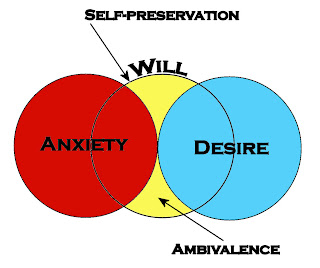After a stressful day, modern man has often reached for the bottle to 'calm his nerves.' A wake is often marked with bouts of drinking. Soldiers suffering from combat exhaustion in the 20th century were often sedated with barbiturates and ether as part of their treatment.
Why?
Well, I've been reading a lot lately on torture and other attempts by men to overcome the human will. After all, addiction is a problem of man's loss of control over his will, so the question becomes how a man can control his will at all, and if he loses control, can someone else step in and take over.
The answer, in short terms and to the extent that I have presently studied (these are fancy words for 'hypothesis' rather than a 'fact') is that a 'will' does not exist in its own right. It is an adjective describing a function or a collection of attributes.
Please allow me to explain: a will to do something or not to do something depends on a lot of other factors. So, to 'will' something means everything has to be in the right order. I'm still mulling over the necessary elements of the will. This is all very new to me, but it is clear that we assume that the will is secondary because we intuitively take actions to take control over our own wills.
After all, if the 'will' is the core decision-making faculty of a human, how could he 'do' something 'against his own will'?
Even Jesus Christ struggled with His human will, but using what? The Gospels are silent, but the implication has always been that He struggled as a human and did not use His divine will.
We struggle all the time with our wills. So, what do we call the other partner in this dance?
This is the partner who knows enough to pick up the bottle and take a drink after a stress-filled work day. This is the decision-maker that lights the joint so that you can relax your wound-up will.
I hope you don't mind, but I've made some crude drawings to demonstrate where this is going:
The three circles represent human awareness. We are 'imprinted' with three characteristics (the borders of the circles): self-preservation, desires, and anxieties. The Will encompasses the territory within self-preservation, but also those desires and anxieties which are compatible with self-preservation. Areas which are yellow represent awareness of things which we have neither desire for or anxiety against.
The Will represents the natural movement of decisions within self-preservation which are about either desire, anxiety, or ambivalence.
So, the anxieties and desires outside the circle of self-preservation are the things which we inherently are afraid of or desire, but know that acting on them goes against self-preservation. For example, you may have a desire to eat in excess, but self-preservation kicks in and cuts off the influence of that desire, so you stop (hopefully). You may have a fear of falling off your bike, but self-preservation kicks in and cuts off that influence so that you can attain the needed social bonds of being a bike rider.
When torture or external suffering come to bear down on the person, it starts to look like this:
Anxiety crowds the territory of self-preservation. Fewer things become ambivalent. However, desire does not necessarily give up its natural space, and so severe oppression eventually creates this confusion between desire and anxiety. In my addiction charts, this is when the 'gear shift' becomes inverted and the person loses his ability to choose, yet still retains knowledge of good and bad.
You see, the 'colors' never leave the awareness, but they can become confused when it comes to their role in self-preservation. In addition, things that we would be afraid to do we lose the 'fear' of doing because of the stresses placed on the person. We can be pushed to do things that we normally would not for the sake of self-preservation.
Once the pressure a released, the circles return to their original positions, hence the person can say that he was forced to do something 'against his will' or normative definitions of desire and anxiety, because all of this is still going on within his awareness, which looks down on all the circles and what is happening to them.
This is one of the horrors of torture, as the person watches his 'will' being distorted by the crowding of anxiety into the circle of self-preservation.
So, what do alcohol and drugs do in this process? Largely, they slow down the human awareness and the pace of decision-making so that time can kick in and the circles return to normal. They keep the system from self-aggravating the stresses by creating more stressful situations.
Again, this is all theoretical. You can email me or post a comment if you see problems with this hypothesis.


No comments:
Post a Comment